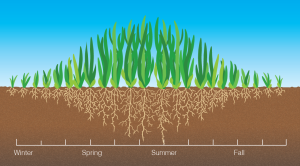
For plants to be healthy and grow they must use sunlight to produce foods from carbon dioxide and water. This process called photosynthesis involves the plant drawing up water from roots, and leaves taking in CO2 from the air and trapping energy from the sun. The energy from the sun turns water and CO2 into sugars used for growth and oxygen which is released into the air.
During winter months a combination of factors including shorter days, reduced light intensity, lower temperatures, and less rainfall cause photosynthesis to dramatically slow and occur only during our reduced daylight hours. Fertilizer supplies needed nutrients for photosynthesis, however when photosynthesis slows with shorter days and lower nighttime temperatures the plant’s need for fertilizer and water are minimal.

In our sub-tropical climate, many plants go into dormancy or semi-dormancy. When deciduous trees and shrubs drop their leaves, they are in dormancy. When turfgrass begins to turn partially straw yellow or slightly brown it is in semi-dormancy. Our warm season turfgrasses grow best at temperatures between 80-95° which typically occur between March and October. Growth slows and the need for fertilizer and water are minimal from October to March due to cooler nights and less sunlight. During the winter turfgrass growth slows and roots slough off. Nutrients are transferred from the shoots to the roots as stored energy for when they are needed for photosynthesis in the spring when temperatures rise, and day length is longer.
Applications of fertilizer and over irrigation during winter months promote fungal and other disease problems as well as weed pressure. Additionally, nutrients from fertilizers may runoff or leach into waterbodies contributing to pollution problems. Applications that promote deep green turfgrass during the winter months do so at the expense of the root system as energy is not stored for spring growth and the reduced root system cannot support the shoot growth. Inappropriate fertilization and irrigation are major causes of lawn deterioration.
The following are fertilization recommendations.
- Utilize slow-release balanced fertilizer products with a 1:1 or 2:1 ratio of nitrogen to potassium and don’t use products with phosphorous unless a soil test indicates a deficiency. Example fertilizer analysis include: 15-0-15, 18-0-18 and 24-0-11.
- Make the last annual fertilizer application during the month of November.
- Make the first spring application in late March or early April once the turf has begun to green up on its own.
- Apply no more than 1 pound of nitrogen at any one time and no more than 4 pounds of nitrogen over the growing season – most turfgrass does very well with much less nitrogen. To figure 1 pound of nitrogen divide 100 by the nitrogen analysis. This will give you the total pounds of that fertilizer to deliver 1 pound of nitrogen for each 1000 square feet of landscape. Example: For a 15-0-15 fertilizer, 100 divided by 15 = 6.7 pounds of fertilizer per 1000 square feet to deliver 1 pound of nitrogen.
- Potassium influences root growth, and water and stress tolerance. Using a balanced 1:1 ratio of nitrogen to potassium usually provides adequate potassium. If in doubt, use a soil test to determine if additional potassium is needed.
- Fertilizers labeled as “winter blends” or “winterizers” should not be applied as most contain high levels of nitrogen. Applications of fertilizer containing high levels of nitrogen are a waste of money and may likely contribute to nutrient leaching and/or runoff to waterbodies.
- Ornamental plants benefit from fertilizer applied to turfgrass as the roots typically extend into turf areas. Ornamental plants should only be fertilized during the establishment period or when a nutrient deficiency is identified. For information on identifying woody ornamental nutrient deficiencies refer to the UF/IFAS publication Nutrient Deficient Symptoms of Woody Ornamentals in South Florida (https://edis.ifas.ufl.edu/publication/EP362).
- Follow your county or municipal Landscape Maintenance and Fertilizer Ordinance.
Understanding landscape plant growth cycles and only applying fertilizer when plants can utilize the nutrients will promote healthy landscapes and prevent nutrients from becoming a source of water pollution.
Note: All images and contents are the property of UF/IFAS.



